Chapter 11 Area Related To Circles
Class 10th Maths NCERT Exemplar Solution
NCERT Exemplar Problems Class 10 Maths Solutions Chapter 11 Area Related To Circles
Exercise 11.1 Multiple Choice Questions (MCQs)
Question
1:
If the sum of the areas of two circles with radii
R1 and R2 is equal to the area of a circle of radius
R, then
Solution:
(b)
According to the given
condition,
Area of circle =Area of first circle + Area of second circle
Question
2:
If the sum of the circumferences of two circles with
radii R1 and R2 is equal to the circumference of
a circle of radius R, then
(a) R1 + R2=R
(b)
R1 + R2 > R
(c) R1 + R2 <
R
(d) Nothing definite can be said about the relation among
R1,R2 and R
Solution:
(a)
According to the given condition,
Circumference of circle = Circumference of
first circle + Circumference of second circle
Question
3:
If the circumference of a circle and the perimeter of a
square are equal, then
(a) Area of the circle = Area of the square
(b)
Area of the circle > Area of the square
(c) Area of the circle < Area
of the square
(d) Nothing definite can be said about the relation between the
areas of the circle and square
Solution:
(b)
According to the given condition,
Circumference of a circle = Perimeter of
square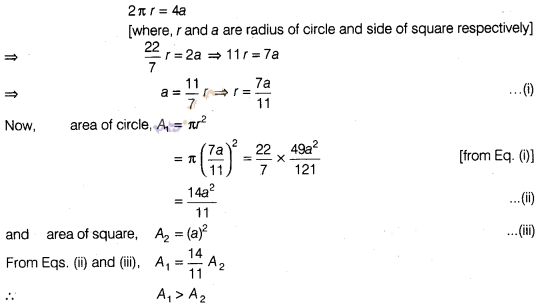
Hence, Area of the
circle > Area of the square.
Question
4:
Area of the largest triangle that can be inscribed in a
semi-circle of radius r units is
(a) r2
squnits
(b) \(\frac { 1 }{ 2 } \) r2 sq
units
(c) 2r2 sq
units
(d) √2 r2 sq units
Solution:
(a)
Take a point C on the circumference of the semi-circle and join it by the end
points of diameter A and B.
Question
5:
If the perimeter of a circle is equal to that of a square,
then the ratio of their areas is
(a) 22
:7
(b)
14:11
(c)
7:22
(d) 11:14
Solution:
(b)
Let radius of circle be r and side of a square be a.
According to the given
condition,
Question
6:
It is proposed to build a single circular park equal in
area to the sum of areas of two circular parks of diameters 16 m and 12 m in a
locality. The radius of the new park would be
(a) 10
m
(b)15m
(c) 20
m
(d) 24 m
Solution:
(a)
Area of first circular park, whose diameter is 16 m
Question
7:
The area of the circle that can be inscribed in a square
of side 6 cm is
(a) 36π
cm2
(b) 18π cm2
(c)
12π
cm2
(d) 9π cm2
Solution:
Question
8:
The area of the square that can be inscribed in a circle
of radius 8 cm is
(a) 256
cm2
(b) 128
cm2
(c)64√2
cm2
(d)64 cm2
Solution:
(b)
Given, radius of circle, r = OC = 8cm.
∴ Diameter of the circle = AC = 2 x OC
= 2 x 8= 16 cm
which is equal to the diagonal of a square.
Let side of
square be x.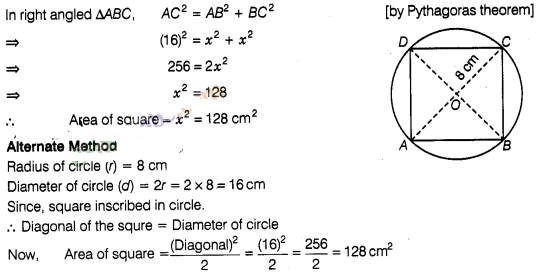
Question
9:
The radius of a circle whose circumference is equal to the
sum of the circumferences of the two circles of diameters 36 cm and 20 cm is
(a) 56
cm
(b) 42
cm
(c) 28
cm
(d) 16 cm
Solution:
(c)
∵ Circumference of first circle = 2 πr = πd1 = 36 π
cm
[given, d1 = 36 cm]
and circumference of second circle =
πd2 = 20 π
cm
[given, d2 = 20
cm]
According to the given condition,
Circumference of circle =
Circumference of first circle + Circumference of second circle
Question
10:
The diameter of a circle whose area is equal to the sum
of the areas of the two circles of radii 24 cm and 7 cm is
(a) 31
cm
(b) 25
cm
(c) 62
cm
(d) 50 cm
Solution:
(d)
Let r1 = 24 cm and r2 = 7 cm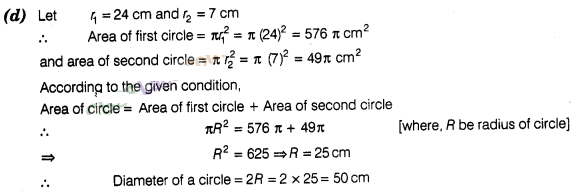
Exercise 11.2 Very Short Answer
Type Questions
Write whether True or False and justify your answer
Question
1:
Is the area of the circle inscribed in a square of side a
cm, πa2 cm2 ? Give reasons for your answer
Solution:
False
Question
2:
Will it be true to say that the perimeter of a square
circumscribing a circle of radius a cm is 80 cm? Give reason for your
answer.
Solution:
Question
3:
In figure, a square is inscribed in a circle of diameter d
and another square is circumscribing the circle. Is the area of the outer square
four times the area of the inner square? Give reason for your answer.
Solution:
False
Given diameter of circle is d.
∴ Diagonal of inner square = Diameter of
circle = d
Let side of inner square EFGH be x.
∴ In right angled
ΔEFG,
But side of the outer
square ABCS = Diameter of circle = d
∴
Area of outer square = d2
Hence, area of outer square is not equal
to four times the area of the inner square.
Question
4:
Is it true to say that area of segment of a circle is less
than the area of its corresponding sector? Why?
Solution:
False
It
is true only in the case of minor segment. But in case of major segment area is
always greater than the area of sector.
Question
5:
Is it true that the distance travelled by a circular wheel
of diameter d cm in one revolution is 2πd cm? Why?
Solution:
False
Because
the distance travelled by the wheel in one revolution is equal to its
circumference i.e., πd.
i.e.,
π(2r) = 2 πr = Circumference of
wheel
[∵d = 2r]
Question
6:
In covering a distance s m, a circular wheel of radius r m
makes \(\frac{s}{2\pi r}\)
revolution. Is this statement true?
Why?
Solution:
True
The
distance covered in one revolution is 2πr i.e., its circumference.
Question
7:
The numerical value of the area of a circle is greater
than the numerical value of its circumference. Is this statement true?
Why?
Solution:
False
If
0< r< 2, then numerical value of circumference is greater than numerical
value of area of circle and if r > 2, area is greater than circumference.
Question
8:
If the length of an arc of a circle of radius r is equal
to that of an arc of a circle of radius 2r, then the angle of the corresponding
sector of the first circle is double the angle of the corresponding sector of
the other circle. Is this statement false? Why?
Solution:
False
Let
two circles C1 and C2 of radius r and 2r with centres O
and O’, respectively.
i.e., angle of the
corresponding sector of C1 is double the angle of the corresponding
sector of C2.
It is true statement
Question
9:
The area of two sectors of two different circles with
equal corresponding arc lengths are equal. Is this statement true? Why?
Solution:
False
It
is true for arcs of the same circle. But in different circle, it is not
possible.
Question
10:
The areas of two sectors of two different circles are
equal. Is it necessary that their corresponding arc lengths are equal?
Why?
Solution:
False
It
is true for arcs of the same circle. But in different circle, it is not
possible
Question
11:
Is the area of the largest circle that can be drawn
inside a rectangle of length a cm and breadth b cm (a > b) is π b2
cm? Why?
Solution:
False
The
area of the largest circle that can be drawn inside a rectangle is π ( \(\frac {
b }{ 2 } \) )² cm, where π \(\frac { b }{ 2 } \) is the radius of the circle and
it is possible when rectangle becomes a square.
Question
12:
Circumference of two circles are equal. Is it necessary
that their areas be equal? Why?
Solution:
True
If
circumference of two circles are equal, then their corresponding radii are
equal. So, their areas will be equal.
Question
13:
Areas of two circles are equal. Is it necessary that
their circumferences are equal? Why?
Solution:
True
If
areas of two circles are equal, then their corresponding radii are equal. So,
their circumference will be equal.
Question
14:
Is it true to say that area of a square inscribed in a
circle of diameter p cm is p2 cm2 ? Why?
Solution:
True
When
the square is inscribed in the circle, the diameter of a circle is equal to the
diagonal of a square but not the side of the square.
Exercise 11.3 Short Answer Type Questions
Question
1:
Find the radius of a circle whose circumference is equal
to the sum of the circumference of two circles of radii 15 cm and 18
cm.
Solution:
Let the
radius of a circle be r.
∴
Circumference of a circle = 2πr
Let the radii of two circles are
r1 and r2 whose values are 15 cm and 18 cm
respectively.
i.e.
r1 = 15cmand r2 = 18cm
Now, by given condition,
Circumference of circle = Circumference of first circle + Circumference of
second circle
⇒
2πr = 2πr1 + 2πr2
⇒
r = r1 + r2
⇒
r = 15 + 18
∴
r = 33 cm
Hence, required radius of a circle is 33 cm.
Question
2:
In figure, a square of diagonal 8 cm is inscribed in a
circle. Find the area of the shaded region.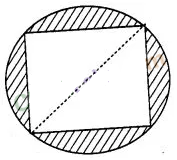
Solution:
Let
the side of a square be a and the radius of circle be r.
Given that, length
of diagonal of square = 8 cm
So, the area of the
shaded region = Area of circle – Area of square
= (16π – 32)
cm2
Hence, the required area of the shaded region is (16π – 32)
cm2.
Question
3:
Find the area of a sector of a circle of radius 28 cm and
central angle 45°.
Solution:
Given that,
Radius of a circle, r = 28 cm
and measure of central angle θ= 45°
Hence,
the required area of a sector of a circle is 308 cm
Question
4:
The wheel of a motor cycle is of radius 35 cm. How many
revolutions per minute must the wheel make, so as to keep a speed of 66
km/h?
Solution:
Given,
radius of wheel, r = 35 cm
Hence, required number
of revolutions per minute is 500.
Question
5:
A cow is tied with a rope of length 14 m at the corner of
a rectangular field of dimensions 20 m x 16 m. Find the area of the field in
which the cow can graze.
Solution:
Let ABCD be
a rectangular field of dimensions 20 m x 16 m . Suppose, a cow is tied at a
point A Let length of rope be AE = 14 m = r (say).
Question
6:
Find the area of the flower bed (with semi-circular ends)
shown in figure
Solution:
Length
and breadth of a circular bed are 38 cm and 10 cm.
∴
Area of
rectangle ACDF = Length x Breadth = 38 x 10 = 380 cm2
Question
7:
In figure, AB is a diameter of the circle, AC = 6 cm and
BC = 8 cm. Find the area of the shaded region, (use π = 3.14)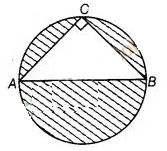
Solution:
Given,
AC = 6 cm and BC = 8 cm
We know that, triangle in a semi-circle with
hypotenuse as diameter is right angled triangle.
Question
8:
Find the area of the shaded field shown in figure.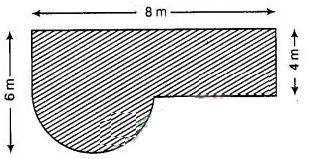
Solution:
In
a figure, join ED
Question
9:
Find the area of the shaded region in figure.
Solution:
join
GH and FE
Question
10:
Find the area of the minor segment of a circle of radius
14 cm, when the angle of the corresponding sector is 60°.
Solution:
Given
that, radius of circle (r) = 14 cm
and angle of the corresponding sector
i.e., central angle (θ) = 60°
Since, in ΔAOB, OA = OB = Radius of circle
i.e., ΔAOB is isosceles.
Question
11:
Find the area of the shaded region in figure, where arcs
drawn with centres A, B, C and D intersect in pairs at mid-point P, Q, R and 5
of the sides AB, BC, CD and DA, respectively of a square ABCD. (use π =
3.14)
Solution:
Given,
side of a square BC = 12 cm
Since, Q is a mid-point of BC.
Question
12:
In figure arcs are drawn by taking vertices A, B and C of
an equilateral triangle of side 10 cm, To intersect the sides BC, CA and AB at
their respective mid-points D, E and F. Find the area of the shaded region, (use
π = 3.14)
Solution:
Since,
ABC is an equilateral triangle.
Question
13:
In figure, arcs have been drawn with radii 14 cm each and
with centres P, Q and R. Find the area of the shaded region.
Solution:
Given
that, radii of each arc (r) = 14 cm
Hence, the
required area of the shaded region is 308 cm2.
Question
14:
A circular park is surrounded by a road 21 m wide. If the
radius of the park is 105 m, then find the area of the road.
Solution:
Question
15:
In figure, arcs have been drawn of radius 21 cm each with
vertices A, B, C and D of quadrilateral ABCD as centres. Find the area of the
shaded region.
Solution:
Given
that, radius of each arc (r) = 21 cm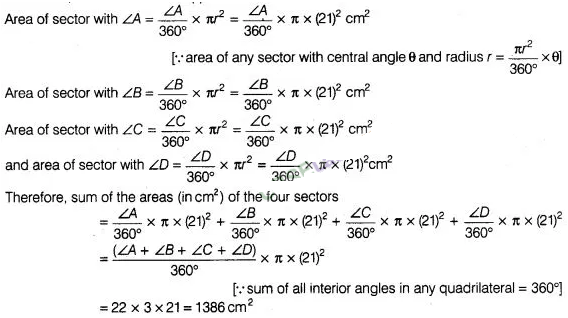
Hence, required area of
the shade region is 1386 cm²
Question
16:
A piece of wire 20 cm long is bent into the from of an
arc of a circle, subtending an angle of 60° at its centre. Find the radius of
the circle.
Solution:
Length of
arc of circle = 20 cm
Exercise 11.4 Long Answer Type Questions
Question
1:
The area of a circular playground is 22176
m2.Find the cost of fencing this ground at the rate of ₹ 50 per
m.
Solution:
Given, area
of a circular playground = 22176 m2
Question
2:
The diameters of front and rear wheels of a tractor are 80
cm and 2m, respectively. Find the number of revolutions that rear wheel will
make in covering a distance in which the front wheel makes 1400
revolutions.
Solution:
Given,
diameter of front wheels, d1 = 80 cm
and diameter of rear wheels,
d2 = 2 m = 200 cm
Question
3:
Sides of a triangular field are 15 m, 16m and 17m. with
the three corners of the field a cow, a buffalo and a horse are tied separately
with ropes of length 7m each to graze in the field.
Find the area of the
field which cannot be grazed by the three animals.
Solution:
Given
that, a triangular field with the three corners of the field a cow, a buffalo
and a horse are tied separately with ropes. So, each animal grazed the field in
each corner of triangular field as a sectorial form.
Given, radius of each
sector (r) = 7m

Question
4:
Find the area of the segment of a circle of radius 12 cm
whose corresponding sector has a centrel angle of 60°. (use π = 3.14)
Solution:
Given that,
radius of a circle (r) = 12 cm
and central angle of sector OBCA (θ) =
60°
Question
5:
A circular pond is 17.5 m is of diameter. It is surrounded
by a 2m wide path. Find the cost of constructing the path at the rate of ₹
25 Per m2?
Solution:
Given that,
a circular pond is surrounded by a wide path.
The diameter of circular pond =
17.5 m

Question
6:
In figure, ABCD is a trapezium with AB || DC. AB = 18 cm,
DC = 32 cm and distance between AB and DC = 14 cm. If arcs of equal radii 7 cm
with centres A, B, C and D have been drawn, then find the area of the shaded
region of the figure.
Solution:
Given,
AB = 18 cm, DC = 32 cm, height, (h) = 14cm
Hence, the required
area of shaded region is 1996 cm²
Question
7:
Three circles each of radius 3.5 cm are drawm in such a
way that each of them touches the other two. Find the area enclosed between
these circles.
Solution:
Given that,
three circles are in such a way that each of them touches the other two.
Now,
we join centre of all three circles to each other by a line segment. Since,
radius of each circle is 3.5 cm.
So;
AB = 2 x Radius of circle
= 2 x 3.5 = 7 cm.
⇒
AC = BC = AB = 7cm
which shows that, ΔABC is an equilateral triangle with
side 7 cm.
We know that, each angle between two adjacent sides of an
equilateral triangle is 60°
∴ Area of sector with angle ∠A =
60°.
Hence, the required
area enclosed between these circles is 1.967 cm2 (approx).
Question
8:
Find the area of the sector of a circle of radius 5 cm, if
the corresponding arc length is 3.5 cm.
Solution:
Let the
central angle of the sector be θ.
Given that, radius of the sector of a
circle (r) = 5 cm.
Hence, required area of
the sector of a circle is 8.75 cm²
Question
9:
Four circular cardboard pieces of radii 7 cm are placed on
a paperin such a way that each piece touches other two pieces. Find the area of
the portion enclosed between these pieces.
Solution:
Given
that, four circular cardboard pieces arc placed on a paper in such a way that
each piece touches other two pieces.
Now, we join centre of all four circles
to each other by a line segment. Since, radius of each circle is 7 cm.
So, AB = 2 x Radius
of circle
= 2×7 = 14cm
⇒ AB =
BC = CD = AD = 14cm
Hence, required area of
the portion enclosed between these pieces is 42 cm2.
Question
10:
On a square cardboard sheet of area 784 cm2,
four congruent circular plates of maximum size are placed such that each
circular plate touches the other two plates and each side of the square sheet is
tangent to two circular plates. Find the area of the square sheet not covered by
the circular plates.
Solution:
Question
11:
Floor of a room is of dimensions 5m x 4m and it is
covered with circular tiles of diameters 50 cm each as shown infigure. Find area
of floor that remains uncovered with tiles, (use π = 3.14)
Solution: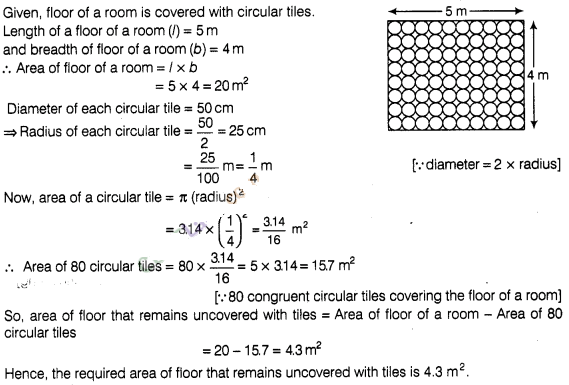
Question
12:
All the vertices of a rhombus lie on a circle. Find the
area of the rhombus, if area of the circle is 1256 cm2, (use π =
3.14)
Solution:
Let the
radius of the circle be r.
Since, all the vertices
of a rhombus lie on a circle that means each diagonal of a rhombus must pass
through the centre of a circle that is why both diagonals are equal and same as
the diameter of the given circle.
Hence, the
required area of rhombus is 800 cm²
Question
13:
An archery target has three regions formed by three
concentric circles as shown in figure. If the diameters of the concentric
circles are in the ratio 1:2:3, then find the ratio of the areas of three
regions.
Solution:
Let
the diameters of concentric circles be k, 2k and 3k.
Question
14:
The length of the minute hand of a clock is 5 cm. Find
the area swept by the minute hand during the time period 6 : 05 am and 6 : 40
am
Solution:
Question
15:
Area of a sector of central angle 200° of a circle is 770
cm2. Find the length of the corresponding arc of this
sector.
Solution:
Let the
radius of the sector AOBA be r.
Question
16:
The central angles of two sectors of circles of radii 7
cm and 21 cm are respectively 120° and 40°. Find the areas of the two sectors as
well as the lengths of the corresponding arcs. What do you observe?
Solution:
Let the
lengths of the corresponding arc be l1 and l2

Hence, we observe that
arc lengths of two sectors of two different circles may be equal but their area
need not be equal.
Question
17:
Find the area of the shaded region given in
figure
Solution:
Join
JK, KL, LM and MJ,
Their are four equally semi-circles and LMJK formed a
square.
Hence, the required of
the shaded region is (180 – 8π)cm².
Question
18:
Find the number of revolutions made by a circular wheel
of area 1.54 m2 in rolling a distance of 176 m.
Solution:
Let
the number of revolutions made by a circular wheel be n and the radius of
circular wheel be r.
Hence, the required
number of revolutions made by a circular wheel is 40.
Question
19:
Find the difference of the areas of two segments of a
circle formed by a chord of length 5 cm subtending an angle of 90° at the
centre.
Solution:
Let the
radius of the circle be r

Question
20:
Find the difference of the areas of a sector of angle
120° and its corresponding major sector of a circle of radius 21 cm.
Solution:
Given that,
radius of the circle (r) = 21 cm and central angle of the sector AOBA (θ) =
120°
Hence, the required
difference of two sectors is 462 cm²